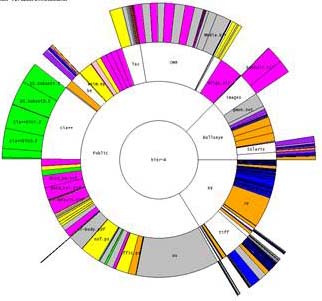Final Project
Introduction
The final project for this course is an opportunity to apply the theories and techniques of visualization learned in this class to a real-world product, most likely a visual web application (though other mediums are fine too). The project can focus on designing a new type of visualization that solves a problem not addressed adequately by current visualization methods, or applying known visualization techniques to an interesting problem in a new way. Other project ideas are possible, subject to approval. We strongly recommend you work in groups of 2-4 people, each with complementary skills and experience in the areas of programming, design, and user research.
Examples of visualizations your projects may aspire to:
Obviously, these were made by experts with more time and experience. These examples should serve as an inspiration.
Project Expectations
- For design projects, the design must follow good information visualization practices, as we will be discussing all quarter in class. These projects should take into account the proper use of visualization components such as color, size, position, animation, and so on.
- Your visualizations should take usability issues into account, and should help the user achieve insight on the underlying data or problem that was not possible without the visualization. By insight I mean making the non-visible visible, or showing trends or patterns or outliers or missing information, or by presenting the underlying information in a more understandable way.
- If you're inventing a new kind of visualization, it might be that your results are not entirely successful. That is ok, but be sure to follow good design principles and thoroughly discuss what did and did not work in your design.
- During the course of the project (not at the end), you should conduct an evaluation of your design with at least three members of your intended user group. So, if you are designing a visualization for musicians, the testers should be musicians.
- The final product should be of high quality and focused scope. Don't succumb to scope creep. Select a project your team can fully execute in the time you have.
Project Milestones (details below)
- 1/12: In-class project pitch
- 1/20: Project proposal due. (Turn in earlier to get feedback sooner.)
- 1/24: Receive feedback on proposals.
- 2/9: In-class "mid-term" demonstrations.
- 3/8: In-class final project demonstrations.
- 3/15: Final paper and deliverable due.
Project Pitch (Due in class Thurs 1/12)
This is an opportunity to share project ideas with each other and form project groups. Come to class with an idea or two of what you'd like to build/design. If you like what someone suggests, there'll be a time to move about the room and begin forming project groups.
When you present, be sure to mention your strengths (design, programming, experience with certain visualization and development tools) so that you can encourage partnerships with people with complementary skills.
Project Proposal (Due Fri 1/20 9pm)
The project proposal is intended to help you formulate a project concept and scope. It should be a short (1-2 pages max) description of your intended project and include any sketches or visual aids needed to clarify your concept. The purpose of this assignment is to let me know what you want to build so I can give you feedback early. If necessary, I may ask you to revise your proposal, most likely by focusing the scope. A well-scoped project will be one that can be fully realized and executed well by 2-4 people working about 50 hours each over the next month and a half.
I expect the style of proposal to vary based on the project, but it should include:
- Names of students involved
- Project concept and goals. What is the purpose of the visualization?
- Discussion of related work. Your projects should be original and hopefully build on the work of others.
- What data (if any) will be used in the visualization.
- Which tools are you considering using to accomplish the goals (this can change if needed).
- What kinds of results you anticipate achieving.
- What kinds of results you would like to achieve but which you probably do not have the time or the tools for.
In-Class "Mid-Term" Demonstration (Due Thu 2/9 11:30am)
On this day, you will demonstrate initial prototypes of your project to the class. Prototypes should start as paper sketches, but by this point you should have moved to a higher-fidelity interactive medium like Apple Keynote or Powerpoint (or perhaps code) so that you can test it with users.
The duration of the demonstration will depend on the number of projects we have.
In-Class "Final" Demonstration (Due Thu 3/8 11:30am)
For this demonstration, you will demonstrate the final version of your visualization to the class. This is an opportunity to show everyone how it works and discuss how you built it.
Final Paper (Due Thu 3/15 11:30am)
The final deliverable is a research paper in the IEEE VisWeek format on the process your team undertook to complete this project. It should be clearly organized and describe what you made and why you made the design that you did. It should demonstrate completion of each of the milestones described on this page, and include images of each stage of the project, including scans of early designs, photos of usability tests, screenshots, etc. Explain the process you undertook to produce your project, rather than just describing the finished work. It should be sufficiently detailed that others could repeat your process simply from reading your document. If you have any questions, please do not hesitate to contact me. The final paper is to be uploaded to the class discussion board.
Project Grading
- Class demonstrations (20%)
- Quality of final writeup (30%)
- Quality of visualization product (50%)
